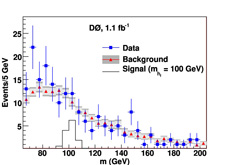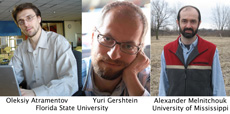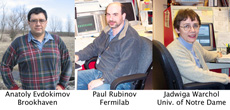|
Thursday, April 10
THERE WILL BE NO PHYSICS AND DETECTOR SEMINAR THIS WEEK
2:30 p.m.
Theoretical Physics Seminar - Curia II
Speaker: K. Wang, University of Wisconsin
Title: Testing the Origin of Neutrino Mass at the LHC
3:30 p.m.
DIRECTOR'S COFFEE BREAK - 2nd Flr X-Over
THERE WILL BE NO ACCELERATOR PHYSICS AND TECHNOLOGY SEMINAR TODAY
Friday, April 11
3:30 p.m.
DIRECTOR'S COFFEE BREAK - 2nd Flr X-Over
4 p.m.
Joint Experimental-Theoretical Physics Seminar - One West
Speaker: A. Sousa, University of Oxford
Title: First Results from Analysis of Neutral Current Neutrino Interactions in MINOS
8 p.m.
Fermilab Lecture Series ***CANCELLED - Auditorium
Speaker: Dr. Cutler Cleveland, Boston University
Title: Energy 101: 10 Things Everyone Should Know About Energy
Click here for NALCAL,
a weekly calendar with links to additional information.
|
Thursday, April 10
- Tomato Florentine
- *Pork BBQ sandwich
- Olive & artichoke paella
- Smart Cuisine: Chicken Marsala
- Smoked turkey melt
- Assorted pizza slices
- SW chicken salad w/roasted corn salsa
Wilson Hall Cafe menu |
|
Thursday, April 10
Dinner
- Closed
Wednesday, April 16
Lunch
- Sesame ginger flank steak w/asparagus
- Banana chocolate egg roll
Chez Leon menu
Call x4598 to make your reservation. |
|
|
Getting dirty for Mother Earth

Fermilab will celebrate Earth Day with a tree planting event on April 30.
On April 30, in place of their lunch routine, Fermilab employees will suit up in old clothes, work boots and gardening gloves to head into the prairie. With shovels in hand, they will work, as they do this time each year, to improve the laboratory's natural landscape by planting trees in honor of Earth Day.
"The event really helps to beautify the laboratory and make people feel that they are giving back to the laboratory and to nature, which they are," said Martin Valenzuela, Roads and Grounds senior groundskeeper and event coordinator.
This year's April 30 Earth Day/Arbor Day event will occur from 11:30 a.m. to 1 p.m. Fermilab volunteers can join Roads and Grounds staff to plant about 65 native hardwood trees, including shagbark hickory, burr oak and bitternut hickory species near the West Wilson Hall Guard House. See map
"That's a beautiful corner," Valenzuela said. "You can see trees slowly coming up that we have planted over the last few years."
The Earth Day tree planting program aligns with Fermilab's mission of land stewardship. The event's sponsoring organization, Fermi Natural Areas, concentrates on increasing conservation and environmental outreach and research efforts. The not-for-profit organization has made a top priority of restoring one of the largest natural savannah areas in Illinois, which sits inside the Main Ring.
Volunteers will receive a hot dog lunch. In the event of rain, tree planting will occur on May 7.
-- Rhianna Wisniewski
|
 |
| Ruth Pordes |
To the editor:
Wednesday's issue of Fermilab Today linked to a Times Online story implying
that CERN, having given the world the Web, went on to produce the Grid, more
or less independently. While CERN has certainly played a strong role, it is
important to recognize that Grid development is a global endeavor with other
equally strong players, funded in the U.S. by the Department of Energy and National Science Foundation. They include the Condor and Globus software projects, national grid infrastructures such as the Open Science Grid and TeraGrid, as well as, more parochially, significant contributions to the worldwide LHC computing enterprise. Success
has many fathers. When it comes to the Grid, however, we should exercise
caution when making paternity claims.
-- Ruth Pordes, OSG Executive Director
|
Arlene Lennox retirement
 |
| Arlene Lennox |
Arlene Lennox will retire today. Join her for cake and coffee at 2 p.m. today on the second floor crossover. Contact Michelle Gleason, x8062, or Ruth DeJerld, x2767, for more information.
|
Orbach appears before Senate appropriators
From AIP FYI, April 9, 2008
It is difficult to draw definite conclusions from Energy Under Secretary for Science Ray Orbach's appearance before the Senate Energy and Water Development Appropriations Subcommittee last week. While support was expressed for the Office of Science, concerns - similar to those raised by House appropriators - were expressed about proposed cuts to other DOE programs.
The clearest indication of Subcommittee Chairman Byron Dorgan's (D-ND) thoughts on the FY 2009 Department of Energy request was found in his opening statement. After discussing the importance of research in energy and energy technologies, Dorgan said:
"Without the scientific and technical breakthroughs in these programs, the United States cannot expect to achieve the lofty goals that we have set for ourselves. Both the administration and the Congress have set very substantial goals in various energy initiatives and in recently enacted energy laws.
"In 2009 in the recommended budget for this department, I think there are some concerns. I will express them during the questions. Science, of course . . . is the beneficiary in the budget request. The $749 million increase is the largest in the department's budget. Energy efficiency is evidently the donor. The $467 million reduction is also the largest reduction in the budget.
Read more
|
Higgs Boson:
A ghost in the machine
From Time, April 10, 2008
Get physicists and cosmologists talking about their work and they will tell you that there are elegant theories and messy ones. Almost all of them believe the universe conforms to an elegant one. A central goal of today's physics, in fact, is to show that at its very beginning, the universe was ordered and unified. But this unity didn't last for long. Just instants after the Big Bang, as the explosion cooled and its contents scattered, the cosmos' forces and matter differentiated. The universe fell from a state of perfect grace into its current complexity, in a cosmic parallel to Adam and Eve.
Many great minds - Democritus, Isaac Newton, James Clerk Maxwell, Albert Einstein - took giant steps toward bringing the universe's lost unity out of hiding. In 1964, Peter Higgs, a shy scientist in Edinburgh, added his name to that list by coming up with an ingenious theory that gave scientists the tools to explain how two classes of particles, which now appear to be different, were once one and the same. His theory proposes the existence of a single particle responsible for imparting mass to all things - a speck so precious it has come to be known as the "God particle." The scientific term for it is the Higgs boson, and to find it physicists are counting on the most powerful particle accelerator ever constructed: the Large Hadron Collider (LHC) at the CERN laboratory in Geneva, a 17-mile underground circuit that took 25 years to plan and $6 billion to build.
Read more
|
|
|
The Higgs' shining beacon

This figure shows the two-photon invariant mass spectrum for the candidate events selected in the DZero fermiophobic Higgs search. Blue and red markers signify the data and expected background events, respectively. The black markers denote the expected signal for a Higgs boson.
Discussions about the Higgs typically involve details on how it could explain particle mass, its preference to couple with particles with large mass and how physicists still don't know how to pinpoint the Higgs' mass. It is therefore somewhat surprising that DZero researchers use photons (particles with zero mass) to search for the Higgs boson. Yet, these particles of light could act as a shining beacon, signaling the Higgs' presence.
The Higgs can only directly interact with massive particles, but the Higgs could indirectly interact with non-massive particles. Photons have no mass, and they can only communicate via a massive, charged interpreter, such as the W boson. This means that the Higgs can decay to two photons, but only in a very rare process for the simplest theoretical Higgs framework. Large enhancements to this rate are possible in more complicated Higgs' models or with the presence of new particles such as axions. This could result in a Higgs boson that would preferentially decay into weak bosons (W or Z) or photons. Physicists call such a particle a fermiophobic Higgs. If the mass of such a particle was much lower than twice the W mass, it would dominantly produce two photons as it decayed. The enhanced rate of a fermiophobic Higgs could produce a clear signature of Higgs production.
A two-photon decay has experimental advantages as well. Photon energies are well-measured at DZero, and the resonant two-photon mass would appear as a narrow peak in the data. There are few background events to this process, and they are relatively well-understood.
DZero physicists searched for a fermiophobic Higgs boson produced in association with a vector boson or via vector boson fusion in 1.1 inverse femtobarns of data. They tested the data for evidence of a two-photon mass resonance from 70-150 GeV/c2 but found none. The null result allows them to set stringent limits on a fermiophobic Higgs boson, which significantly improve the existing results from previous experiments. Though they found no evidence, these DZero researchers will continue to watch for the Higgs' shining photon beacon.
Read more

This group of DZero researchers made primary contributions this analysis.

This group of DZero collaborators are current key contributors to the reliable and efficient operation of the preshower detectors. These detectors improve particle identification and enhance the robustness of analyses such as described here.
Result of the Week Archive
|
|
Have a safe day!
Vacancy in DOE Office of Science
The U.S. Department of Energy's Office of Science Office of High Energy Physics seeks a highly qualified candidate with outstanding research and leadership skills to fill the position of Facilities Division Director. Obtain more information and apply here.
Stamp machine, pay phone removed
The stamp machine previously located on the ground floor of Wilson Hall was removed by the U.S. Postal Service. U.S.P.S. does not plan to replace the machine. The payphone was also removed.
FermiGrid 201, 202 offered
FermiGrid 201: Scripting and Running Grid Jobs
This introductory course is offered for individuals who work with or have an interest in grid computing.
Learn more and enroll
FermiGrid 202: Grid Storage Access
This class includes lab time.
Learn more and enroll.
TIAA CREF retirement counseling
Chad Stein from TIAA CREF will conduct retirement counseling sessions at Fermilab on Thursday, April 10. You may schedule an appointment by calling (800) 842-2005, x5602 or using the TIAA CREF Web site.
Computer programming course
"Fine Points of C++ Pointers: Dumb, Smart, and Smarter," the second course in the current series of "Selected Topics in Computer Programming," is offered on Thursday, April 10. Aimed at programmers with C++ experience, it will deal in depth with issues related to pointer manipulation in C++ programs. Attendees will learn best-practice techniques of resource management in modern standard C++, as well as related new techniques from the next C++ standard.
Participants of the free course will receive TRAIN credit. Course registration is now open. Future courses will occur at two-week intervals.
International Folk Dance April 10
International Folk Dancing returns to Kuhn Barn this week, Thursday, April 10. Dancing begins at 7:30 p.m. with teaching and children's dances earlier in the evening and request dancing later on. Newcomers are welcome and you do not need to come with a partner. Info at (630) 584-0825 or (630) 840-8194 or folkdance@fnal.gov.
Additional Activities |
|